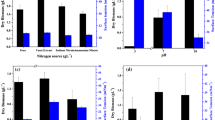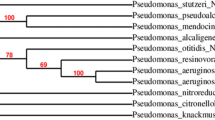Abstract
Biosurfactants are non-toxic, surface-active biomolecules capable of reducing surface tension (ST) and emulsifying interface at a comparably lower concentration than commercial surfactants. Yet, poor yield, costlier substrates, and complex cultivation processes limit their commercial applications. This study focuses on producing biosurfactants by Pseudomonas aeruginosa P7815 in batch and fed-batch bioreactor systems using waste cooking oil (WCO) as the sole carbon source. The batch study showed a 92% of WCO biodegradation ability of P. aeruginosa producing 11 g L−1 of biosurfactant. To enhance this biosurfactant production, a fed-batch oil feeding strategy was opted to extend the stationary phase of the bacterium and minimize the effects of substrate deprivation. An enhanced biosurfactant production of 16 g L−1 (i.e. 1.5 times of batch study) was achieved at a feed rate of 5.7 g L−1d−1 with almost 94% of WCO biodegradation activity. The biosurfactant was characterized as rhamnolipid using Fourier transform infrared spectroscopy (FTIR), and its interfacial characterization showed ST reduction to 29 ± 1 mN m−1 and effective emulsification stability at pH value of 4, temperature up to 40 °C and salinity up to 40 g L−1. The biosurfactant exhibited antibacterial activity with minimum inhibitory concentration (MIC) values of 100 µg mL−1 and 150 µg mL−1 for pathogenic E. hirae and E. coli, respectively. These findings suggest that biodegradation of WCO by P. aeruginosa in a fed-batch cultivation strategy is a potential alternative for the economical production of biosurfactants, which can be further explored for biomedical, cosmetics, and oil washing/recovery applications.

source in BH media with NaNO3 as N source (1 g L−1)

source and 1 g L−1 of NaNO3 as N source in BH media with an intermittent WCO feed rate of 5.7 g L−1d−1 after 48 h




Similar content being viewed by others
References
Santos DKF, Rufino RD, Luna JM, Santos VA, Sarubbo LA (2016) Biosurfactants: multifunctional biomolecules of the 21st century. Int J Mol Sci 17(3):401
Datta P, Tiwari P, Pandey LM (2018) Isolation and characterization of biosurfactant producing and oil degrading Bacillus subtilis MG495086 from formation water of Assam oil reservoir and its suitability for enhanced oil recovery. Biores Technol 270:439–448
Datta P, Tiwari P, Pandey LM (2020) Oil washing proficiency of biosurfactant produced by isolated Bacillus tequilensis MK 729017 from Assam reservoir soil. J Petrol Sci Eng 195:107612
Sharma S, Datta P, Kumar B, Tiwari P, Pandey LM (2019) Production of novel rhamnolipids via biodegradation of waste cooking oil using Pseudomonas aeruginosa MTCC7815. Biodegradation 30:301–312
Fopase R, Pathode SR, Sharma S, Datta P, Pandey LM (2020) Lipopeptide and essential oil based nanoemulsion for controlled drug delivery. Polymer Plastics Technol Mater 59(18) :2076–2086
Wu J, Zhang J, Wang P, Zhu L, Gao M, Zheng Z, Zhan X (2017) Production of rhamnolipids by semi-solid-state fermentation with Pseudomonas aeruginosa RG18 for heavy metal desorption. Bioprocess Biosyst Eng 40:1611–1619
Verma R, Sharma S, Kundu LM, Pandey LM (2020) Experimental investigation of molasses as a sole nutrient for the production of an alternative metabolite biosurfactant. J Water Proc Eng 38:101632
Weuster-Botz D (2000) Experimental design for fermentation media development: statistical design or global random search? J Biosci Bioeng 90(5):473–483
Heins A-L, Weuster-Botz D (2018) Population heterogeneity in microbial bioprocesses: origin, analysis, mechanisms, and future perspectives. Bioprocess Biosyst Eng 41:889–916
Gong Z, He Q, Che C, Liu J, Yang G (2020) Optimization and scale-up of the production of rhamnolipid by Pseudomonas aeruginosa in solid-state fermentation using high-density polyurethane foam as an inert support. Bioprocess Biosyst Eng 43(3):385–392
Lan G, Fan Q, Liu Y, Chen C, Li G, Liu Y, Yin X (2015) Rhamnolipid production from waste cooking oil using Pseudomonas SWP-4. Biochem Eng J 101:44–54
Shi J, Chen Y, Liu X, Li D (2021) Rhamnolipid production from waste cooking oil using newly isolated halotolerant Pseudomonas aeruginosa M4. J Cleaner Prod 278:123879
Jamal P, Nawawi W, Alam MZ (2012) Optimum medium components for biosurfactant production by Klebsiella pneumoniae WMF02 utilizing sludge palm oil as a substrate. Aust J Basic Appl Sci 6(1):100–108
Md Badrul Hisham NH, Ibrahim MF, Ramli N, Abd-Aziz S (2019) Production of biosurfactant produced from used cooking oil by Bacillus sp. HIP3 for heavy metals removal. Molecules 24(14):2617
Zhu L, Yang X, Xue C, Chen Y, Qu L, Lu W (2012) Enhanced rhamnolipids production by Pseudomonas aeruginosa based on a pH stage-controlled fed-batch fermentation process. Biores Technol 117:208–213
He N, Wu T, Jiang J, Long X, Shao B, Meng Q (2017) Toward high-efficiency production of biosurfactant rhamnolipids using sequential fed-batch fermentation based on a fill-and-draw strategy. Colloids Surf B 157:317–324
Luo Z, Yuan X-z, Zhong H, Zeng G-m, Liu Z-f, Ma X-l, Zhu Y-y (2013) Optimizing rhamnolipid production by Pseudomonas aeruginosa ATCC 9027 grown on waste frying oil using response surface method and batch-fed fermentation. J Central South Univer 20:1015–1021
Wu J, Zhang J, Zhang H, Gao M, Liu L, Zhan X (2019) Recycling of cooking oil fume condensate for the production of rhamnolipids by Pseudomonas aeruginosa WB505. Bioprocess Biosyst Eng 42(5):777–784
Sharma S, Pandey LM (2020) Production of biosurfactant by Bacillus subtilis RSL-2 isolated from sludge and biosurfactant mediated degradation of oil. Bioresource Technol 307:123261
Sharma S, Verma R, Pandey LM (2019) Crude oil degradation and biosurfactant production abilities of isolated Agrobacterium fabrum SLAJ731. Biocatal Agric Biotechnol 21:101322
Sabavath G, Rahman M, Sarmah T, Dihingia P, Srivastava DN, Sharma S, Pandey L, Kakati M (2020) Single-step, DC thermal plasma-assisted synthesis of Ag-C nanocomposites with less than 10 nm sizes for antibacterial applications. J Phys D Appl Phys 53:365201
Zambry NS, Rusly NS, Awang MS, Noh NAM, Yahya ARM (2021) Production of lipopeptide biosurfactant in batch and fed-batch Streptomyces sp. PBD-410L cultures growing on palm oil. Bioprocess Biosyst Eng 44(7):1577–1592
Hoshan L, Jiang R, Moroney J, Bui A, Zhang X, Hang TC, Xu S (2019) Effective bioreactor pH control using only sparging gases. Biotechnol Prog 35(1):e2743
Prabhu Y, Phale PS (2003) Biodegradation of phenanthrene by Pseudomonas sp. strain PP2: novel metabolic pathway, role of biosurfactant and cell surface hydrophobicity in hydrocarbon assimilation. Appl Microbiol Biotechnol 61:342–351
Anic I, Apolonia I, Franco P, Wichmann R (2018) Production of rhamnolipids by integrated foam adsorption in a bioreactor system. AMB Express 8:122
Md Noh N, Mohd Salleh S, Yahya A (2014) Enhanced rhamnolipid production by P seudomonas aeruginosa USM-AR 2 via fed-batch cultivation based on maximum substrate uptake rate. Lett Appl Microbiol 58:617–623
Müller MM, Hörmann B, Syldatk C, Hausmann R (2010) Pseudomonas aeruginosa PAO1 as a model for rhamnolipid production in bioreactor systems. Appl Microbiol Biotechnol 87:167–174
Noh NAM, Salleh SM, Abdullah A, Mohd AR (2012) Fed-batch cultivation of Pseudomonas aeruginosa USM-AR2 producing rhamnolipid in bioreactor through pulse feeding strategy. Int Conf Biol Life Sci 40(34):168–174
Xu N, Liu S, Xu L, Zhou J, Xin F, Zhang W, Qian X, Li M, Dong W, Jiang M (2020) Enhanced rhamnolipids production using a novel bioreactor system based on integrated foam-control and repeated fed-batch fermentation strategy. Biotechnol Biofuels 13(1):1–10
Saikia RR, Deka S, Deka M, Banat I (2012) Isolation of biosurfactant-producing Pseudomonas aeruginosa RS29 from oil-contaminated soil and evaluation of different nitrogen sources in biosurfactant production. Ann Microbiol 62(2):753–763
Ehinmitola EO, Aransiola EF, Adeagbo OP (2018) Comparative study of various carbon sources on rhamnolipid production. S Afr J Chem Eng 26:42–48
Ahmad Z, Zhang X, Imran M, Zhong H, Andleeb S, Zulekha R, Liu G, Ahmad I, Coulon F (2021) Production, functional stability, and effect of rhamnolipid biosurfactant from Klebsiella sp. on phenanthrene degradation in various medium systems. Ecotoxicol Environml Safety 207:111514
Velmurugan M, Baskaran A, Kumar S, Sureka I, Arockia Raj E, Emelda J, Sathiyamurthy K (2015) Screening, stability and antibacterial potential of rhamnolipids from Pseudomonas sp., isolated from hydrocarbon contaminated soil. J App Pharm Sci 5 (8):26–33
Saxena V, Pandey LM (2020) Bimetallic assembly of Fe(III) doped ZnO as an effective nanoantibiotic and its ROS independent antibacterial mechanism. J Trace Elem Med Biol 57:126416
Fopase R, Saxena V, Seal P, Borah JP, Pandey LM (2020) Yttrium iron garnet for hyperthermia applications: Synthesis, characterization and in-vitro analysis. Mater Sci Eng 116:111163
Lotfabad TB, Abassi H, Ahmadkhaniha R, Roostaazad R, Masoomi F, Zahiri HS, Ahmadian G, Vali H, Noghabi KA (2010) Structural characterization of a rhamnolipid-type biosurfactant produced by Pseudomonas aeruginosa MR01: enhancement of di-rhamnolipid proportion using gamma irradiation. Colloids Surf B 81(2):397–405
Samadi N, Abadian N, Ahmadkhaniha R, Amini F, Dalili D, Rastkari N, Safaripour E, Mohseni FA (2012) Structural characterization and surface activities of biogenic rhamnolipid surfactants from Pseudomonas aeruginosa isolate MN1 and synergistic effects against methicillin-resistant Staphylococcus aureus. Folia Microbiol 57:501–508
Ramos da Silva A, Manresa MÁ, Pinazo A, García MT, Pérez L (2019) Rhamnolipids functionalized with basic amino acids: Synthesis, aggregation behavior, antibacterial activity and biodegradation studies. Colloids Surf B 181:234–243
de Freitas FJ, Vieira EA, Nitschke M (2019) The antibacterial activity of rhamnolipid biosurfactant is pH dependent. Food Res Int 116:737–744
Díaz De Rienzo MA, Stevenson P, Marchant R, Banat IM (2015) Antibacterial properties of biosurfactants against selected Gram-positive and -negative bacteria. FEMS Microbiol Lett 363(2):fnv224
Costa SG, Nitschke M, Lépine F, Déziel E, Contiero J (2010) Structure, properties and applications of rhamnolipids produced by Pseudomonas aeruginosa L2–1 from cassava wastewater. Process Biochem 45(9):1511–1516
Ndlovu T, Rautenbach M, Vosloo JA, Khan S, Khan W (2017) Characterisation and antimicrobial activity of biosurfactant extracts produced by Bacillus amyloliquefaciens and Pseudomonas aeruginosa isolated from a wastewater treatment plant. AMB Express 7:108
Bharali P, Saikia JP, Ray A, Konwar BK (2013) Rhamnolipid (RL) from Pseudomonas aeruginosa OBP1: A novel chemotaxis and antibacterial agent. Colloids Surf B 103:502–509
El-Sheshtawy HS, Doheim MM (2014) Selection of Pseudomonas aeruginosa for biosurfactant production and studies of its antimicrobial activity. Egypt J Pet 23(1):1–6
Zhao F, Han S, Zhang Y (2020) Comparative studies on the structural composition, surface/interface activity and application potential of rhamnolipids produced by Pseudomonas aeruginosa using hydrophobic or hydrophilic substrates. Bioresource Technol 295:122269
Acknowledgements
The authors would like to thank the Department of Science and Technology, Government of India for financial assistance (Sanction No. SR/FST/LS-II/2017/120) for this work. The authors would like to acknowledge the Central Instrument Facility, IIT Guwahati for allowing access to various facilities.
Author information
Authors and Affiliations
Corresponding author
Ethics declarations
Conflict of interest
Authors declare no conflicts of interest.
Additional information
Publisher's Note
Springer Nature remains neutral with regard to jurisdictional claims in published maps and institutional affiliations.
Rights and permissions
About this article
Cite this article
Sharma, S., Verma, R., Dhull, S. et al. Biodegradation of waste cooking oil and simultaneous production of rhamnolipid biosurfactant by Pseudomonas aeruginosa P7815 in batch and fed-batch bioreactor. Bioprocess Biosyst Eng 45, 309–319 (2022). https://doi.org/10.1007/s00449-021-02661-0
Received:
Accepted:
Published:
Issue Date:
DOI: https://doi.org/10.1007/s00449-021-02661-0




